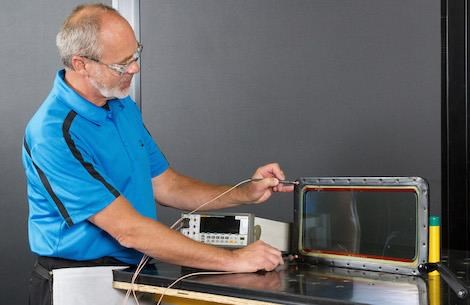PPG Donates Military Coatings, Window for EC-135C Aircraft Restoration
PPG donated a boom operator compartment side window and will donate military aircraft coatings to the Strategic Air Command and Aerospace Museum, a Smithsonian affiliate in Ashland, Nebraska.

PPG production employee Michael Holloway, a retired U.S. Air Force technical sergeant, checks electrical resistance of the anti-icing heating system as part of the final inspection on a boom operator compartment side window for an EC-135C “Looking Glass” aircraft.
PPG donated a boom operator compartment side window and will donate military aircraft coatings to the Strategic Air Command and Aerospace Museum, a Smithsonian affiliate in Ashland, Nebraska, for restoration of an EC-135C aircraft that was one of the last to fly as the U.S. Air Force Strategic Air Command’s “Looking Glass.”
For retired U.S. Air Force Tech. Sgt. Michael Holloway, command-and-control airplane AF-38049 was the first Looking Glass mission on which he flew. Now a PPG employee, Holloway proposed the idea for the window donation to PPG, and the company decided to donate the coatings, too.
“Upon examination of my flight records I discovered that 049 was my very first Looking Glass Mission on Nov. 11, 1987,” said Holloway, a production employee at PPG’s Huntsville, Alabama, aircraft transparencies plant where the heated window was made to replace a broken one. “Like most Looking Glass missions, it was 8.3 hours in duration, and we took off from and returned to Offutt Air Force Base, Nebraska. Over my three years as a crew member of the Looking Glass, I flew 222 sorties and accumulated 1,910 hours of flight time, and 21 of those sorties were aboard 049.”
“We are very excited to be restoring this important aircraft and grateful for the support of donors like PPG,” said Dr. Michael McGinnis, executive director for the museum. “Looking Glass served an important role in the U.S. strategic deterrence plans and was the reason the U.S. won the Cold War.”
Working with the museum’s restoration team, PPG military coatings experts selected high-solids Desoprime HS 7233 military epoxy primer to prohibit corrosion and enhance topcoat adhesion, as well as high-solids Desothane HS 8200 series military and defense exterior topcoat in gray and white to restore the aircraft’s appearance. The PPG protective topcoat affords ease of application, which was important to the museum’s painter, and will create a long-lasting world-class finish.
The boom operator compartment side window is located in the EC-135C’s aft belly, and PPG made the original one as well as the aircraft’s other transparencies. Lying in the compartment, the boom operator would transfer fuel to an aircraft flying behind the EC-135C by “flying” the refueling boom to a receptacle on the receiving aircraft.
“These aircraft served a vital role in the Cold War as a nuclear deterrent,” Holloway said. “I am proud to have been a part of such a historic mission, and I look forward to visiting the museum to see this glorious airplane and possibly volunteering with the restoration in the near future.”
PPG’s global aerospace business offers coatings, sealants, transparencies, packaging and application systems, and transparent armor, as well as chemical management and other services. For more information, visit www.ppgaerospace.com.
Related Content
-
Anodizing for Bonding Applications in Aerospace
Anodizing for pre-prep bonding bridges the gap between metallic and composite worlds, as it provides a superior surface in many applications on aluminum components for bonding to these composites.
-
Wastewater Contamination Removal System
Each environmentally beneficial system treats the wastewater stream at a fraction of the cost of larger, more complex industrial systems.
-
Finishing High Reliability, Function Critical Parts
From safety critical automotive and aerospace components to lifesaving medical micro-components and implantable devices, Indiana-based Electro-Spec finishes applications that require zero failure rates.















